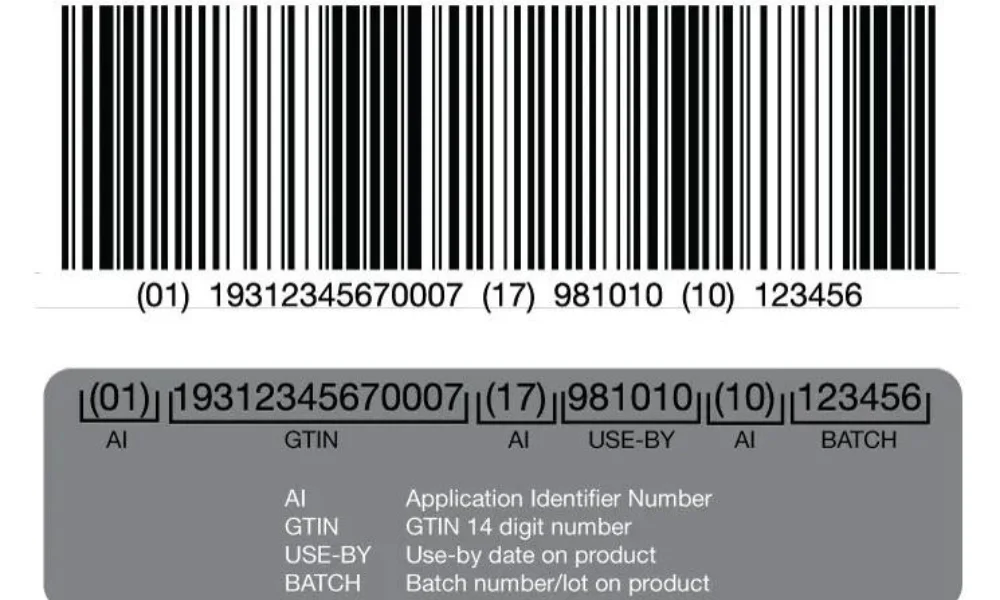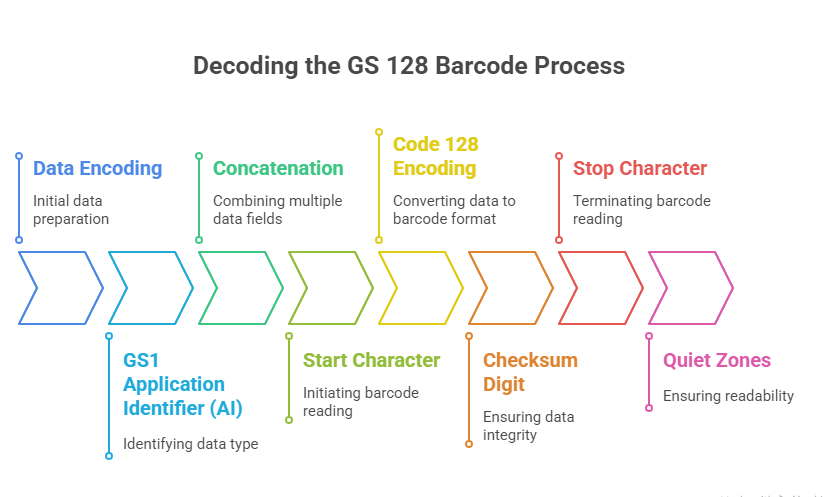In today’s fast-paced world, barcodes are crucial in streamlining supply chains, improving inventory management, and enhancing overall efficiency in various industries. Among the numerous barcode standards, the GS1-128, also known as GS1 DataBar or GS1-128, stands out as a versatile and powerful format.
Capable of encoding essential product data like batch numbers, expiration dates, and weight, in addition to standard product identification numbers, the GS1-128 barcode format has become indispensable in modern business operations.
This in-depth exploration will delve into the structure, benefits, and practical applications of the GS1-128 barcode format, shedding light on its significance in today’s market.

What Is GS 128 Barcode Format?
The supply chain management, retail, and logistics industries frequently employ barcodes in the GS1-128, UCC-128, or EAN-128 formats.
It is an application standard within the GS1 System, which enables the encoding and communication of data along with the barcode symbology. GS1-128 barcodes are based on Code 128 and can carry various types of information, including product details, batch numbers, expiration dates, and other relevant data. Some of the key features of the GS1-128 barcode format include :

1. Data Capacity
GS1-128 barcodes may hold up to 48 characters of data, including letters, numbers, and special symbols, providing ample storage capacity.
In industries like the pharmaceutical industry, where the barcode must convey extensive product information, this function is important. It makes it possible to keep track of information on medications, including dose, lot numbers, and expiration dates.
2. Compatibility
GS1-128 barcodes are designed to be compatible with various types of barcode scanners and reading devices. This compatibility ensures businesses and organizations can adopt GS1-128 without worrying about significant changes to their existing scanning infrastructure. It allows for seamless integration and a smoother transition to using GS1-128 barcodes.
3. Global Standard
GS1-128 is a part of the GS1 System, an international organization that sets standards for identification and communication in supply chains. Since GS1-128 barcodes adhere to a predetermined structure, they are readable and understandable in a wide range of countries and industries.
This lessens the possibility of confusion while promoting global interoperability.
4. Application Identifier (AI)
The GS1-128 barcode uses Application Identifiers (AIs) to specify the encoded data type. AIs are two-digit numeric codes that precede the data and indicate the meaning of the data. For example, AI (01) shows a Global Trade Item Number (GTIN), AI (10) represents a batch or lot number, and AI (17) indicates an expiration date. The use of AIs adds flexibility to the barcode and allows for the inclusion of diverse data elements.
5. Variable Data Length
Different data items can have varying data lengths supported by GS1-128 barcodes. Because the barcode doesn’t have a set length like some other barcode formats, it can contain data fields of different sizes. As a result, GS1-128 is more versatile and adaptive to different business needs because it can customize itself to individual data requirements.
6. Data Validation
GS1-128 barcodes include check digits to guarantee correctness and lower the possibility of scanning errors. Based on an analysis of the data and a mathematical algorithm, the barcode has check digits. The check digit is used by the scanner to confirm that it has correctly read the information from the barcode. The check digit will not match if there is a data or scan error, which will cause a rescan or error message.
7. Concatenation
When a single GS1-128 barcode cannot hold all the data, more barcodes can be concatenated. For applications like shipping labels that must encode lengthy product lists, this is crucial.
8. Human-Readable Interpretation
GS1-128 barcodes include a human-readable interpretation (HRI) below the barcode. This HRI displays the data encoded in the barcode using alphanumeric characters, making it easy for users to confirm the information encoded in it visually. HRI acts as a fallback if the barcode cannot be scanned or manual data entry is necessary.
9. Application Flexibility
Different industries can use GS1-128 barcodes since they are adaptable and configurable. They enable a variety of applications, including logistics, inventory management, and product tracking, thanks to their common structure and capacity to incorporate different AIs.
10. Track and Trace
GS1-128 barcodes are instrumental in enabling way and trace capabilities in the supply chain. By encoding unique identifiers like GTINs, batch numbers, and serial numbers, businesses can accurately track the movement of products from the point of origin to the final destination.
This traceability enhances supply chain visibility, simplifies product recalls, and helps prevent counterfeiting and diversion.
The GS1-128 barcode format’s essential features, such as its high data capacity, compatibility, global standardization, application identifiers, variable data length support, data validation, concatenation, human-readable interpretation, application flexibility, and track and trace capabilities, make it a powerful tool for businesses aiming to optimize their supply chain management and logistics operations.
How Does the GS 128 Barcode Works?
Data is encrypted via the GS1 System using GS1-128, sometimes referred to as UCC/EAN-128. To store data about products and shipments, it frequently finds use in retail, healthcare, and logistics.
The GS1 System is used to encrypt data using GS1-128, sometimes referred to as UCC/EAN-128. It is commonly used for product and shipment information in retail, healthcare, and logistics. According to GS1 standards, these barcodes can carry both alphabetic and numerical data. These actions provide as an example of how it operates.

1. Data Encoding:
The first step is to gather the necessary data to be encoded in the barcode. This data can include product identification numbers (GTIN), batch or lot numbers, serial numbers, expiration dates, and any other relevant information. Gather and format each piece of data precisely in accordance with GS1 requirements.
2. GS1 Application Identifier (AI):
The GS1 Application Identifier (AI) is a two, three, or four-digit numeric code that identifies the meaning and format of the data following it. For example, the AI “01” represents the GTIN, “10” represents the batch or lot number, and “17” illustrates the expiration date. Each AI is a prefix for the corresponding data element, enabling the scanner to interpret the information correctly.
3. Concatenation:
Additionally, multiple AIs and their corresponding data are combined to form a continuous data string. The order of AIs is essential, as it determines the sequence in which the scanner will read the data. Notably, the GS1-128 barcode can encode several pieces of data, making it suitable for complex product information and supply chain applications.
4. Start Character:
The barcode begins with a unique start character, often the character ‘Ò’ (Code 128 Start A). The start character indicates to the scanner that it is about to read a GS1-128 barcode. It serves as a reference point for the scanner to identify the beginning of the barcode.
5. Code 128 Encoding:
The data string, which includes the AIs and their corresponding data values, is encoded using the Code 128 symbology. Code 128 is a high-density barcode symbology that efficiently encodes alphanumeric characters and special symbols. The Code 128 encoding process converts each character of the data string into a corresponding pattern of bars and spaces representing the data.
6. Checksum Digit:
A checksum digit is calculated from the encoded data string to enhance barcode accuracy and provide error detection capabilities. To calculate the checksum digit, a calculation is performed using the values of each character in the data string. The barcode scanner uses the checksum digit to make sure it has correctly read the data before scanning the barcode.
7. Stop Character:
The barcode ends with a unique stop character, usually the character ‘Ó’ (Code 128 Stop). The stop character indicates to the scanner that it has reached the end of the barcode,and as a result, the decoding process is complete. Similar to the start character, the stop character helps the scanner accurately identify the barcode’s future.
8. Quiet Zones:
Quiet zones, also known as the clear space, are added before the start character and after the stop character. These blank spaces are essential to allow barcode scanners to detect the beginning and end of the barcode correctly. The quiet zones ensure no other objects or text interfere with the scanning process and improve the barcode’s overall readability.
The GS1-128 barcode can be produced and printed on a product or shipping label so that it can be read by barcode readers or scanners.
The scanner decodes the information, and the relevant systems then process the encoded data to retrieve product details, manage inventory, and facilitate efficient supply chain operations.
Conclusion
GS1-128 is a barcode format that uses GS1 standards to encode data in various industries, such as retail and logistics. It is an extension of the Code 128 barcode and can carry more information like batch numbers, expiration dates, and serial numbers. GS1-128 enables efficient and accurate tracking of products throughout the supply chain.
In conclusion, the GS1-128 barcode format is crucial for enhanced inventory management and traceability in modern businesses. If you’re looking to implement GS1-128 barcodes or need assistance with barcode solutions, Qodenext is your reliable partner. They offer expert guidance and cutting-edge technology to streamline operations and boost efficiency. Take your business to new heights with Qodenext’s barcode solutions today!
FAQ: Understanding the GS1 128 Barcode Format in Depth
1. What is a GS1-128 barcode, and how is it different from a regular barcode?
A GS1-128 barcode can store more information than a regular barcode, like batch numbers, expiration dates, and serial numbers, making it useful for detailed tracking.
2. Why is the GS1-128 barcode widely used in supply chain and logistics?
It helps track products accurately, improves inventory management, and ensures smooth operations across suppliers, warehouses, and retailers.
3. Can a GS1-128 barcode be scanned using any barcode scanner?
Yes, most 1D barcode scanners can read it, but the system must understand GS1 format to interpret the data correctly.
4. What kind of information can be encoded in a GS1-128 barcode?
It can hold product IDs, batch numbers, serial numbers, expiration dates, and more—all in one barcode.
5. What are Application Identifiers (AIs), and why are they important?
AIs are short codes in the barcode that tell the scanner what type of data follows, like a date or a product number.
6. How much data can a GS1-128 barcode hold?
It can hold up to 48 characters, and if needed, more barcodes can be added to carry additional information.
7. Is GS1-128 suitable for small businesses, or is it only for large enterprises?
It’s useful for businesses of all sizes. Even small companies can use it to improve tracking and meet industry standards.
8. How does GS1-128 help with traceability and product recalls?
It makes it easier to track products through the supply chain, so issues like recalls can be handled quickly and accurately.
9. Is there a human-readable version of the barcode data?
Yes, the barcode includes printed text underneath so you can read the data without scanning.
10. How can Qodenext help businesses adopt GS1-128 barcode solutions?
Qodenext offers tools, tech, and support to help you set up and use GS1-128 barcodes effectively in your operations.






